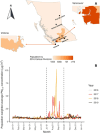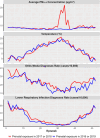Wildfire Seasons, Prenatal PM2.5 Exposure, and Respiratory Infections by Age 1 Year: A Population-Based Case-Control Analysis of Critical Developmental Windows
- PMID: 39539462
- PMCID: PMC11555639
- DOI: 10.1021/acsestair.4c00213
Wildfire Seasons, Prenatal PM2.5 Exposure, and Respiratory Infections by Age 1 Year: A Population-Based Case-Control Analysis of Critical Developmental Windows
Abstract
The 2017 and 2018 wildfire seasons in British Columbia (BC), Canada were unprecedented. Among all the pollutants in wildfire smoke, fine particulate matter (PM2.5) poses the most significant risk to human health. There is limited research on prenatal wildfire smoke exposure and its impacts on infant health. We used a population-based nested case-control design to assess the association between daily PM2.5 exposures during specific developmental windows and the occurrence of otitis media or lower respiratory infections by age 1 year, including infections associated with dispensations of the antibiotic amoxicillin. We observed the strongest association between per 10 μg/m3 increase in PM2.5 exposure and otitis media during the fourth window of eustachian tube development (weeks 19-28) with an OR [95% confidence interval] of 1.31 [1.22, 1.41]. Similarly, the canalicular stage of lower respiratory tract development (weeks 18-27) was associated with the highest odds of lower respiratory infections, with an OR of 1.21 [1.15, 1.28]. Measures to reduce wildfire smoke exposure during pregnancy are warranted.
© 2024 The Authors. Published by American Chemical Society.
Conflict of interest statement
The authors declare no competing financial interest.
Figures





Similar articles
-
Staying Ahead of the Epidemiologic Curve: Evaluation of the British Columbia Asthma Prediction System (BCAPS) During the Unprecedented 2018 Wildfire Season.Front Public Health. 2021 Mar 12;9:499309. doi: 10.3389/fpubh.2021.499309. eCollection 2021. Front Public Health. 2021. PMID: 33777871 Free PMC article.
-
Sub-Daily Exposure to Fine Particulate Matter and Ambulance Dispatches during Wildfire Seasons: A Case-Crossover Study in British Columbia, Canada.Environ Health Perspect. 2020 Jun;128(6):67006. doi: 10.1289/EHP5792. Epub 2020 Jun 24. Environ Health Perspect. 2020. PMID: 32579089 Free PMC article.
-
Wildfire-specific Fine Particulate Matter and Risk of Hospital Admissions in Urban and Rural Counties.Epidemiology. 2017 Jan;28(1):77-85. doi: 10.1097/EDE.0000000000000556. Epidemiology. 2017. PMID: 27648592 Free PMC article.
-
Seasonal ambient particulate matter and population health outcomes among communities impacted by road dust in British Columbia, Canada.J Air Waste Manag Assoc. 2017 Sep;67(9):986-999. doi: 10.1080/10962247.2017.1315348. Epub 2017 May 12. J Air Waste Manag Assoc. 2017. PMID: 28498778
-
Assessment of the Air Quality Health Index (AQHI) and four alternate AQHI-Plus amendments for wildfire seasons in British Columbia.Can J Public Health. 2020 Feb;111(1):96-106. doi: 10.17269/s41997-019-00237-w. Epub 2019 Jul 8. Can J Public Health. 2020. PMID: 31286460 Free PMC article.
References
-
- Bowman W. S.; Schmidt R. J.; Sanghar G. K.; Thompson G. R. III; Ji H.; Zeki A. A.; Haczku A. Air That Once Was Breath” Part 1: Wildfire-Smoke-Induced Mechanisms of Airway Inflammation–“Climate Change, Allergy and Immunology” Special IAAI Article Collection: Collegium Internationale Allergologicum Update 2023. Int. Arch. Allergy Immunol. 2024, 185 (6), 600–616. 10.1159/000536578. - DOI - PMC - PubMed
LinkOut - more resources
Full Text Sources
